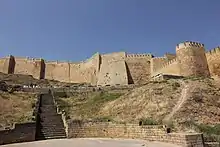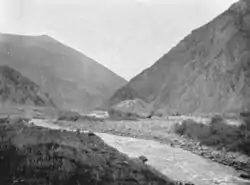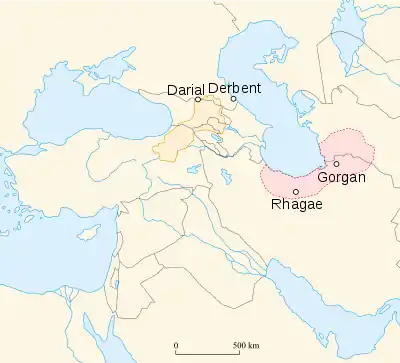
The Gates of Alexander, also known as the Caspian Gates, is a term that refers to a mountain pass that is meant to be associated with Alexander the Great, and in antiquity, especially refers to one enclosed by a physical barrier to prevent an incursion from barbarian tribes, imagined as a symbolic boundary separating the civilized from the uncivilized world.[1] Due to confusion over the exact location of this pass, this term had come to be used for multiple sites, including the original in Iran but later came to dominantly be used for a region in the Caucasus due to a confusion described already by Pliny the Elder in the first century.[2] Only the passage at Rhagae between Media and Parthia, which Alexander crossed while pursuing Darius III, is said to be linked with the historical Alexander.[3] Today, the term "Gates" refers, not to physical gates, but to several mountain passes in this region of the world which acted as "gates" from one area to another.[2]
In later literature, the Caspian Gates has also been identified with two other locations: the Pass of Derbent, Russia, or with the Pass of Dariel, a gorge forming a pass between Russia and Georgia with the Caspian Sea to the east. Tradition also connects it to the Great Wall of Gorgan (Red Snake) on its south-eastern shore. These fortifications were historically part of the defence lines built by the Sassanid Persians, while the Great Wall of Gorgan may have been built by the Parthians.
Literary traditions

The name Caspian Gates originally applied to the narrow region at the southeast corner of the Caspian Sea, through which Alexander actually marched in the pursuit of Darius III, although he did not stop to fortify it.[3] The name was transferred to the passes through the Caucasus, on the other side of the Caspian, by the more fanciful historians of Alexander.
Pliny the Elder
Pliny the Elder (23 AD – 25 August 79 AD) in his Natural History criticises this error, and distinguishes the Gates of the Caucasus from the true Caspian Gates through which Alexander passed. He describes the Gates of the Caucasus as a vast natural feature in a mountain chain rent asunder. Here, he says gates with iron covered beams have been placed above a horribly odorous river, along with a fortress to bar the passage of the innumerable tribes. These gates divide the world into two portions.[4]
Josephus
Josephus, a Jewish historian in the 1st century, gives the first extant reference to gates constructed by Alexander, designed to be a barrier against the Scythians.[5] According to this historian, the people whom the Greeks called Scythians were known (among the Jews) as Magogites, descendants of Magog in the Hebrew Bible. These references occur in two different works. The Jewish War states that the iron gates Alexander erected were controlled by the king of Hyrcania (on the south edge of the Caspian), and allowing passage of the gates to the Alans (whom Josephus considered a Scythic tribe) resulted in the sack of Media. Josephus's Antiquities of the Jews contains two relevant passages, one giving the ancestry of Scythians as descendants of Magog son of Japheth, and another that refers to the Caspian Gates being breached by Scythians allied to Tiberius during the Armenian War.[lower-alpha 1][6]
Pseudo-Hegesippus
In his description of the Alans, Pseudo-Hegesippus follows Josephus in mentioning the construction by Alexander of an iron gate to section off the barbarian group. In the first of two references to this gate, Ps. Hegesippus, places its location at the Taurus Mountains. This is mentioned in the context of a discussion on Alexander's founding of the Antioch of the Orontes, and therefore represents Alexander not only as a founder of civilization but also its protector. In the second reference, it is informed that Alexander had confined the Alans among other savage nations but that, either due to a bribe or political conflict, they were able to persuade the king of Hyrcania to let them burst out. Although not itself apocalyptic, the description of Ps. Hegesippus foreshadows the development of the apocalyptic narrative of Gog and Magog behind Alexander's wall, for it is first in his text that the notion is developed that the tribe behind the wall have actually been confined or imprisoned behind it.[7]
Jerome
Jerome states in the late-fourth century in his seventy-seventh letter that "the gates of Alexander keep back the wild peoples behind the Caucasus". Like Ps. Hegesippus, and unlike the later traditions of the Syrian church, Jerome was concerned with the Greco-Roman discourses on civilization and barbarity as opposed to apocalypse.[7]
Jordanes
Jordanes was a Byzantine author of the sixth century. In a detailed discussion on the Amazons in a Latin work of his named the Getica, he wrote that Alexander had built a set of gates and called them the Caspian Gates. These gates, he said, were guarded by the Laz people of Roman Georgia.[1]
Procopius
The Gates are also mentioned in Procopius' History of the Wars: Book I. Here they are mentioned as the Caspian Gates and they are a source of diplomatic conflict between the Byzantines and the Sassanid Persians. When the current holder of the gates dies, he bequeaths it to Emperor Anastasius. Anastasius, unable and unwilling to finance a garrison for the gates, loses them in an assault by the Sassanid King Cabades (Kavadh I). After peace, Anastasius builds the city of Dara, which would be a focus point for war during the reign of Justinian and site of the Battle of Dara. In this war, the Persians once again bring up the gates during negotiations, mentioning that they block the pass to the Huns for the benefit of both Persians and Byzantines, and that the Persians deserve to be compensated for their service.[8]

Alexander Romance
The Gates occur in later versions of the Alexander Romance of Pseudo-Callisthenes. This version locates the gates between two mountains called the "Breasts of the North" (Greek: Μαζοί Βορρά[9]). The mountains are initially 18 feet apart and the pass is rather wide, but Alexander's prayers to God causes the mountains to draw nearer, thus narrowing the pass. There he builds the Caspian Gates out of bronze, coating them with fast-sticking oil. The gates enclosed twenty-two nations and their monarchs, including Goth and Magoth (Gog and Magog). The geographic location of these mountains is rather vague, described as a 50-day march away northwards after Alexander put to flight his Belsyrian enemies (the Bebrykes,[10] of Bithynia in modern-day North Turkey).[11][12]
Syriac Alexander Legend
In the late antique Christian Alexander Legend the gates were supposedly transformed to a wall built by Alexander in the Caucasus to keep the apocalyptic nations of Gog and Magog.[13] At its outset, the Syriac Alexander Legend (otherwise known as the Neshana) records Alexander constructing a wall of iron to prevent an invasion of the Huns that would result in the plunder of peoples and countries. Alexander commanded that the gate should be constructed out of iron and bronze, for which he recruited three thousand blacksmiths to work the latter and three thousand other men for the former. However, it was believed that the barbarian tribes would break through during the apocalypse.[14]
Tiburtine Sibyl
More indirect, the Tiburtine Sibyl records that Alexander "enclosed" the people of Gog and Magog to prevent their incursion from the north, coinciding with the statement that at some point in the future they will rise again and break through.[15]
Quran
A similar narration is mentioned in al-Kahf ("The Cave"), the 18th chapter of the Quran. According to the Quranic narrative, Gog and Magog (Arabic: يأجوج ومأجوج Yaʾjūj wa-Maʾjūj) were walled off by Dhu al-Qarnayn ("possessor of the Two Horns"), a righteous ruler and conqueror who reached the west and the east. The barrier was constructed with melted iron sheets and covered with copper.[16][17]
Late Medieval literature
During the Middle Ages, the Gates of Alexander story was included in travel literature such as the Travels of Marco Polo and the Travels of Sir John Mandeville. The identities of the nations trapped behind the wall are not always consistent, however; Mandeville claims Gog and Magog are really the Ten Lost Tribes of Israel, who will emerge from their prison during the End Times and unite with their fellow Jews to attack the Christians. Polo speaks of Alexander's Iron Gates, but says the Comanians are the ones trapped behind it. He does mention Gog and Magog, however, locating them north of Cathay. Some scholars have taken this as an oblique and confused reference to the Great Wall of China, which he does not mention otherwise. The Gates of Alexander may represent an attempt by Westerners to explain stories from China of a great king building a great wall. Knowledge of Chinese innovations such as the compass and south-pointing chariot is known to have been diffused (and confused) across Eurasian trade routes.
Other medieval literature, such as the Latin Frankish Chronicle of Fredegar in the first half of the seventh century and the tenth-century Armenian History of Movsēs Dasxurancʿi connected Alexander's gates especially to events during the reign of Heraclius, the Byzantine emperor who defeated the Sasanian Empire in their great war of the first decades of the seventh century.[18]
The medieval German legend of the Red Jews was partially based on stories of the Gates of Alexander. The legend disappeared before the 17th century.
Geographical identifications
Medieval
In medieval world maps, the land of Gog and Magog is generally shown as a region in the far north, northeast, or east of Asia, enclosed by mountains or fortifications and often featuring a gate. It is depicted in this way on Arabian world maps starting from the 10th century, as also on the Tabula Rogeriana, an influential map drawn in 1154 by Muhammad al-Idrisi for Roger II of Sicily.[19]
Modern

(
It is not clear which precise location Josephus meant when he described the Caspian gates. It may have been the Gates of Derbent (lying due east, nearer to Persia), or it may have been the Darial Gorge, lying west, bordering Iberia, located between present-day Ingushetia and Georgia.
However, neither of these were within Hyrcania, but lay to the north and west of its boundaries. Another suggestion is some mountain pass in the Taurus-Zagros Mountains, somewhere near Rhaegae, Iran, in the heart of Hyrcania.[20]
Derbent
The Gates of Alexander are most commonly identified with the Caspian Gates of Derbent, whose thirty north-looking towers used to stretch for forty kilometers between the Caspian Sea and the Caucasus Mountains, effectively blocking the passage across the Caucasus.
Derbent was built around a Sassanid Persian fortress, which served as a strategic location protecting the empire from attacks by the Gokturks. The historical Caspian Gates were not built until probably the reign of Khosrow I in the 6th century, long after Alexander's time, but they came to be credited to him in the passing centuries. The immense wall had a height of up to twenty meters and a thickness of about 10 feet (3 m) when it was in use.
Darial
The Pass of Dariel or Darial has also been known as the "Gates of Alexander" and is a strong candidate for the identity of the Caspian Gates.[21]
Wall of Gorgan
An alternative theory links the Caspian Gates to the so-called "Alexander's Wall" (the Great Wall of Gorgan) on the south-eastern shore of the Caspian Sea, 180 km of which is still preserved today, albeit in a very poor state of repair.[22]
The Great Wall of Gorgan was built during the Parthian dynasty simultaneously with the construction of the Great Wall of China and it was restored during the Sassanid era (3rd–7th centuries)[23]
See also
Notes
- Explanatory notes
- ↑ Josephus, Antiquities of the Jews 1.123 and 18.97; The Jewish War 7.244-51
- Citations
- 1 2 Stoneman, Richard; Nawotka, Krzysztof; Wojciechowska, Agnieszka (2018). The Alexander Romance: history and literature. Ancient narrative. Groningen: Barkhuis & Groningen University Library. pp. 205–206. ISBN 978-94-92444-71-4.
- 1 2 Meserve, Margaret (2009). Empires of Islam in Renaissance Historical Thought. Harvard University Press. pp. 252–253. ISBN 9780674040953.
- 1 2 Anderson, Andrew Runni (1928). "Alexander at the Caspian Gates". Transactions and Proceedings of the American Philological Association. 59: 130–163. doi:10.2307/282983. ISSN 0065-9711. JSTOR 282983.
- ↑ Pliny the Elder, Natural History Book 6.12 and 6.15 cited in Meserve, Margaret (2008). Empires of Islam in Renaissance historical thought. USA: Harvard historical studies. pp. 249–254. ISBN 978-0-674-02656-8.
- ↑ Meserve, Margaret (2008). Empires of Islam in Renaissance historical thought. USA: Harvard historical studies. p. 254. ISBN 978-0-674-02656-8.
- ↑ Bietenholz 1994, p. 122.
- 1 2 Stoneman, Richard; Nawotka, Krzysztof; Wojciechowska, Agnieszka (2018). The Alexander Romance: history and literature. Ancient narrative. Groningen: Barkhuis & Groningen University Library. pp. 208–212. ISBN 978-94-92444-71-4.
- ↑ History of the Wars Books I and II https://www.gutenberg.org/files/16764/16764-h/16764-h.htm
- ↑ Anderson 1932, p. 37.
- ↑ Anderson 1932, p. 35.
- ↑ Stoneman, Richard (tr.), ed. (1991), The Greek Alexander Romance, Penguin, pp. 185–187, ISBN 9780141907116
- ↑ Anderson (1932), p. 11.
- ↑ Van Donzel & Schmidt 2010, pp. 25–49.
- ↑ Tesei, Tommaso (2023). The Syriac Legend of Alexander's Gate. Oxford University Press. pp. 173–179.
- ↑ Tesei, Tommaso (2023). The Syriac Legend of Alexander's Gate. Oxford University Press. p. 119.
- ↑ Van Donzel & Schmidt 2010, p. 57, fn. 3.
- ↑ Dathorne, O. R. (1994). Imagining the World: Mythical Belief Versus Reality in Global Encounters. Greenwood. pp. 45–46. ISBN 0897893646. Retrieved February 5, 2013.
- ↑ Tesei, Tommaso (2023). The Syriac Legend of Alexander's Gate. Oxford University Press. p. 28.
- ↑ Gow 1998, pp. 68–70.
- ↑ Van Donzel & Schmidt 2010, p. 11.
- ↑ Anderson (1932), p. 15–20.
- ↑ Kleiber 2006
- ↑ Omrani Rekavandi, H., Sauer, E., Wilkinson, T. & Nokandeh, J. (2008), The enigma of the red snake: revealing one of the world's greatest frontier walls, Current World Archaeology, No. 27, February/March 2008, pp. 12–22. PDF 5.3 MB Archived 2011-09-28 at the Wayback Machine. p. 13
References
- Anderson, Andrew Runni (1932), Alexander's Gate, Gog and Magog: And the Inclosed Nations, Medieval academy of America, p. 11, ISBN 9780910956079
- Artamonov, Mikhail. "Ancient Derbent" (Древний Дербент). in: Soviet Archaeology, No.8, 1946.
- Bietenholz, Peter G. (1994). Historia and fabula: myths and legends in historical thought from antiquity to the modern age. Brill. ISBN 9004100636.
- Gow, Andrew Colin (1998). "Gog and Magog On Mappaemundi and Early Printed World Maps: Orientalizing Ethnography in the Apocalyptic Tradition". Journal of Early Modern History. 2 (1): 61–88. doi:10.1163/157006598X00090.
- Kleiber, Katarzyna (July 2006). "Alexander's Caspian Wall – A Turning-Point in Parthian and Sasanian Military Architecture?". Folia Orientalia. 42/43: 173–95.
- Van Donzel, E. J.; Schmidt, Andrea Barbara, eds. (2010). "Alexander and Gog and Magog in Early Oriental Christian Sources". Gog and Magog in Early Eastern Christian and Islamic Sources. Brill's Inner Asian Library. Vol. 22 (1st ed.). Leiden and Boston: Brill Publishers. pp. 15–49. doi:10.1163/9789047427629_003. ISBN 978-90-47-42762-9.